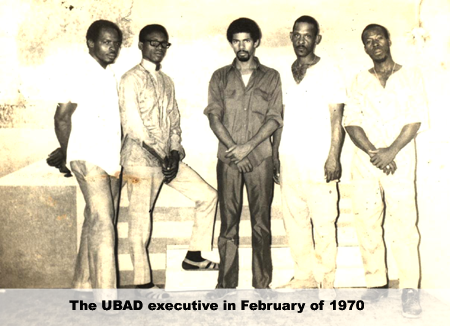When you read this on Tuesday morning, February 9, 2010, it will be exactly 41 years since UBAD, the parent movement for the Kremandala experience, was founded in Belize, at a farm 26 miles on the Northern Highway actually. UBAD lasted for four full years, then a year and a half more in a divided form, until it was dissolved in November of 1974.
The Ex-Servicemen’s Riot of July 1919, for its part, lasted for only two days, but it was a massive benchmark in the socio-political history of British Honduras. It is difficult for us to analyze the impact and repercussions of the 1919 Riot, because we know so little about it. 41 years after the 1919 Riot, by comparison and contrast to UBAD after 41 years, nobody in British Honduras knew anything about it. It was never discussed. By 1960, the 1919 Riot had been completely swept under the historical rug by the colonial authorities, in collusion with the educational system and the elite native class.
In 1960, incidentally, Tony Soberanis, the leader of the Labor and Unemployed Association (LUA) which ruled the streets of the capital in 1934, was still alive. He was a barber who had his shop on Queen Street next to The Belize Times Press/Independence Hall. Students in the schools of Belize were never taught anything about LUA. Soberanis would sometimes mention it, quite infrequently, in the context of the People’s United Party (PUP) uprising which had begun in 1950 following devaluation.
We are trying to give you a sense of how easy it was for the authorities here in the first part of the twentieth century to erase from the records and the memory of the people, major popular developments which had taken place just a couple decades before.
But it was not as if it was only the British who were assiduous in their obliteration of any local history which they considered unpleasant. Today, even the PUP faithful know almost nothing about the six years of PUP history before George Price took over the party in 1956.
The reality of the UBAD movement has only survived because the movement produced a newspaper, followed by a radio station twenty years later, and then a television station. Plus, the UBAD group was so young that several of its officers and a number of its members are still on the scene, 41 years later.
For their own reasons, political propagandists from the two major political parties have attempted to brand the Citizens Organized for Liberty through Action (COLA) organization, a young roots group which emerged with a June 2008 demonstration against Lord Michael Ashcroft, as a Kremandala organization. Kremandala supports COLA, but COLA is fundamentally different from UBAD, which was a black-conscious, cultural organization. COLA is multi-ethnic, multi-racial, and is speaking on a range of issues.
Let us return to Belize, the capital city of British Honduras in 1919. First of all, what happened on July 22 and 23, 1919, was not a riot. It was a revolution – two days during which black people, led by soldiers who had served in Mesopotamia (Iraq) during World War I, overthrew the colonial authorities, wreaked havoc in the center of the city, and terrorized the exploitative commercial class. What colonial military presence existed, was absolutely inadequate to deal with the revolutionaries. A battleship was sent for from Jamaica.
The only source we have on this matter is the research of a British historian named Peter Ashdown, who published his material about 30 years ago. It is difficult to understand what happened after black power had taken over Belize for those two days in 1919. It appears that the leaders of the Ex-Servicemen who emerged after the putsch, primarily Samuel Haynes and an officer by the name of MacDonald, decided to restore a new form of law and order in the capital. How the colonial authorities resumed their role as administrators of the city and country is not adequately explained by Ashdown. There was no military “beat down” of the revolutionaries. It appears they gave up power voluntarily. Several of the more aggressive revolutionaries subsequently served time in Her Majesty’s Prison. Ashdown does not provide enough information, but, praise God, he gave us some. Were it not for the British historian, our ignorance of July 22 and 23, 1919, would have remained total.
UBAD ceased to exist because the society essentially had no room for a third political force in the first-past-the-post system. UBAD had become political because it was too large and too influential to remain cultural. The government considered UBAD a threat. Half of UBAD was absorbed into the new UDP founded in September of 1973.
Politics is the most important game in Belize. There is a five-year cycle involved. Every five years there is a general election. Normally, the party which loses goes into hibernation. The real action takes place in the two years before each general election. Those movements which have emerged during the three years of relative hibernation by the Opposition, whichever of the two major political parties it is, are swept aside in the run up to the big election. This has been a two-party game – UDP and PUP.
In 1969, it would have been beneficial to UBAD’s leaders to know the history of the Ex-Servicemen’s Riot of 1919 and the LUA uprising of 1934. Likewise, down the road a knowledge of UBAD’s history will benefit the leaders and thinkers of COLA or any other roots organization which emerges by and from the will and energy of the Belizean people.
Power to the people. Power in the struggle.

